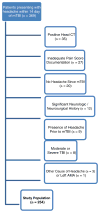Intravenous migraine therapy in children with posttraumatic headache in the ED
- PMID: 25676851
- PMCID: PMC4430402
- DOI: 10.1016/j.ajem.2015.01.053
Intravenous migraine therapy in children with posttraumatic headache in the ED
Abstract
Background: More than 3.8 million children sustain traumatic brain injuries annually. Treatment of posttraumatic headache (PTH) in the emergency department (ED) is variable, and benefits are unclear.
Objective: The objective of the study is to determine if intravenous migraine therapy reduces pain scores in children with PTH and factors associated with improved response.
Methods: This was a retrospective study of children, 8 to 21 years old, presenting to a tertiary pediatric ED with mild traumatic brain injury (mTBI) and PTH from November 2009 to June 2013. Inclusion criteria were mTBI (defined by diagnosis codes) within 14 days of ED visit, headache, and administration of one or more intravenous medications: ketorolac, prochlorperazine, metoclopramide, chlorpromazine, and ondansetron. Primary outcome was treatment success defined by greater than or equal to 50% pain score reduction during ED visit. Bivariate analysis and logistic regression were used to determine predictors of treatment success: age, sex, migraine or mTBI history, time since injury, ED head computed tomographic (CT) imaging, and pretreatment with oral analgesics.
Results: A total of 254 patients were included. Mean age was 13.8 years, 51% were female, 80% were white, mean time since injury was 2 days, and 114 patients had negative head CTs. Eighty-six percent of patients had treatment success with 52% experiencing complete resolution of headache. Bivariate analysis showed that patients who had a head CT were less likely to respond (80% vs 91%; P = .008).
Conclusions: Intravenous migraine therapy reduces PTH pain scores for children presenting within 14 days after mTBI. Further prospective work is needed to determine long-term benefits of acute PTH treatment in the ED.
Copyright © 2015 Elsevier Inc. All rights reserved.
Conflict of interest statement
Conflict of interest: The authors have no conflicts of interest to disclose.
Figures
Similar articles
-
Relative Effectiveness of Dopamine Antagonists for Pediatric Migraine in the Emergency Department.Pediatr Emerg Care. 2018 Mar;34(3):165-168. doi: 10.1097/PEC.0000000000000718. Pediatr Emerg Care. 2018. PMID: 27176905
-
The Use of a Pediatric Migraine Practice Guideline in an Emergency Department Setting.Pediatr Emerg Care. 2016 Jul;32(7):435-9. doi: 10.1097/PEC.0000000000000525. Pediatr Emerg Care. 2016. PMID: 26359823
-
A comparison of acute treatment regimens for migraine in the emergency department.Pediatrics. 2015 Feb;135(2):232-8. doi: 10.1542/peds.2014-2432. Pediatrics. 2015. PMID: 25624377
-
Rescue therapy for acute migraine, part 3: opioids, NSAIDs, steroids, and post-discharge medications.Headache. 2012 Mar;52(3):467-82. doi: 10.1111/j.1526-4610.2012.02097.x. Headache. 2012. PMID: 22404708 Review.
-
BET 1: Metoclopramide or prochlorperazine for headache in acute migraine?Emerg Med J. 2013 Jul;30(7):595-6. doi: 10.1136/emermed-2013-202853.1. Emerg Med J. 2013. PMID: 23765765 Review.
Cited by
-
Efficacy of outpatient infusion therapy in pediatric patients with postconcussive headaches.Childs Nerv Syst. 2022 Jan;38(1):103-108. doi: 10.1007/s00381-021-05383-6. Epub 2021 Oct 20. Childs Nerv Syst. 2022. PMID: 34671849
-
Randomized Study of Metoclopramide Plus Diphenhydramine for Acute Posttraumatic Headache.Neurology. 2021 May 4;96(18):e2323-e2331. doi: 10.1212/WNL.0000000000011822. Epub 2021 Mar 24. Neurology. 2021. PMID: 33762421 Free PMC article. Clinical Trial.
-
Post-Traumatic Headache Therapy in the Athlete.Curr Pain Headache Rep. 2016 Jun;20(6):41. doi: 10.1007/s11916-016-0568-6. Curr Pain Headache Rep. 2016. PMID: 27184059 Review.
-
An exploratory study of IV metoclopramide+diphenhydramine for acute post-traumatic headache.Am J Emerg Med. 2018 Feb;36(2):285-289. doi: 10.1016/j.ajem.2017.10.034. Epub 2017 Oct 13. Am J Emerg Med. 2018. PMID: 29074068 Free PMC article. Clinical Trial.
-
Acute and chronic management of posttraumatic headache in children: A systematic review.Headache. 2021 Nov;61(10):1475-1492. doi: 10.1111/head.14236. Epub 2021 Dec 4. Headache. 2021. PMID: 34862612 Free PMC article.
References
-
- Moreno MA. Youth sports and concussion risk. Arch Pediatr Adolesc Med. 2012;166(4):396. - PubMed
-
- Bazarian JJ, McClung J, Shah MN, Cheng YT, Flesher W, Kraus J. Mild traumatic brain injury in the United States, 1998–2000. Brain Inj. 2005;19(2):85–91. - PubMed
-
- Blinman TA, Houseknecht E, Snyder C, Wiebe DJ, Nance ML. Postconcussive symptoms in hospitalized pediatric patients after mild traumatic brain injury. J Pediatr Surg. 2009;44(6):1223–8. - PubMed
-
- Blume HK, Vavilala MS, Jaffe KM, Koepsell TD, Wang J, Tempkin N, et al. Headache after pediatric traumatic brain injury: a cohort study. Pediatrics. 2012;129(1):e31–9. - PubMed
-
- Powers SW, Patton SR, Hommel KA, Hershey AD. Quality of life in childhood migraines: clinical impact and comparison to other chronic illnesses. Pediatrics. 2003;112(1 Pt 1):e1–5. - PubMed
Publication types
MeSH terms
Substances
Grants and funding
LinkOut - more resources
Full Text Sources
Other Literature Sources
Medical
Research Materials



